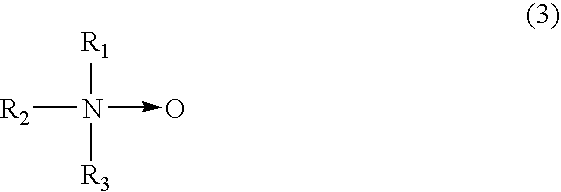Synergistic combination of fungicides to protect wood and wood-based products and wood treated by such combination as well as methods of making the same
a technology of fungicides and fungicides, applied in the field of synergistic combination of fungicides to protect wood, can solve the problems of cosmetic damage (stain, mold and mildew), structural degradation (decay), and damage to both solid wood and wood-based composites, and achieves the effect of favorable health/safety/environmental profile and cost-effectiveness
- Summary
- Abstract
- Description
- Claims
- Application Information
AI Technical Summary
Benefits of technology
Problems solved by technology
Method used
Image
Examples
example 1
[0054]One (1) g of Amical 48 (97–99% diiodomethyl-p-tolyl-sulfone, available from Dow Chemical) and 62.00 g of Barlox 1260PG (60% N-alkyl(C 12–C16)-N,N-dimethylamine oxide, 25% propylene glycol, 15% water, available from Lonza), were added together and mixed until solution was clear. 8.25 g of Glycol DPM (100% dipropylene glycol monomethyl ether, available from Shell, Arco Chemical) was added to mixer and allowed to mix until solution was clear. 0.1 g of a defoamer was added to the mixture and mixed until completely dispersed. 1.0 g of a deodorizer was added to mixture, and the entire solution was mixed until clear. 8.75 g of Polyphase AF-1 (40% 3-iodo-2-propynyl-n-butyl carbamate, available from Troy Chemical Co.) was added to mix and agitated until solution is clear. 7.0 g of Wocosen 50 TK (50% propiconazole, 50% dipropylene glycol monomethyl ether, available from Janssen) was added to tank mixture and then agitated until solution was clear. Finally, 11.90 g of a surfactant was ad...
example 2
Antisapstain Control—Laboratory Test
1. Samples were prepared as follows:
[0057]Samples were taken from Red Pine branches approximately 10 mm in diameter after the bark was removed and cut into 2–4 mm thickness. Samples were treated (30 second dip) in the various preservative treatments and then allowed to air dry for one hour. Samples were then put into the test and were not sterilized.
2. Preparation of Cultures
[0058]Pure or group cultures were propagated at least four days in advance on a 7 cm filter paper soaked with 3 ml nutrient solution in a test tube. After growth covered the filter paper, 15 ml of sterile distilled water was added to the tube and macerated until the sample was homogenized.
3. Preparation of Test Chamber
[0059]The test chamber was a petri dish with a connecting duct to a water reservoir and a lid with an 0.2 mm micropore vapor port. The reservoir was taped to the petri dish with heat resistant tape, and then filled with distilled water. A piece of cellulose spong...
example 3
Field Test Data
[0070]The dimensions of the wood samples are typically 2 in. by 4 in. and 0.5 m in length. Hardboards such as Red Oak and Gum typically varied in width. Boards were cut and then randomly selected from the various wood species. 25 samples of each treatment were used for testing. An endeavor was made to select only sapwood to ensure heartwood had a minimal affect on later assessments.
[0071]Preservative retentions of solutions were taken at the beginning and at the end of testing. Solution pick-up is measured before and after wood samples are dipped into treating solution.
[0072]The following results in Table 9 show how the present invention provides unique protection against sapstain fungi in the field when compared to the industry standard NP-1 (7.6% IPBC, 64.8% DDAC).
[0073]Test samples were observed for fungal growth. The percentage of attack on the surface of the samples was recorded. A 0% (No attack)100% (complete attack) rating scale was used.
[0074]
TABLE 9SpeciesHem...
PUM
| Property | Measurement | Unit |
|---|---|---|
| thickness | aaaaa | aaaaa |
| diameter | aaaaa | aaaaa |
| weight | aaaaa | aaaaa |
Abstract
Description
Claims
Application Information
 Login to View More
Login to View More - R&D
- Intellectual Property
- Life Sciences
- Materials
- Tech Scout
- Unparalleled Data Quality
- Higher Quality Content
- 60% Fewer Hallucinations
Browse by: Latest US Patents, China's latest patents, Technical Efficacy Thesaurus, Application Domain, Technology Topic, Popular Technical Reports.
© 2025 PatSnap. All rights reserved.Legal|Privacy policy|Modern Slavery Act Transparency Statement|Sitemap|About US| Contact US: help@patsnap.com



